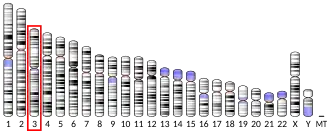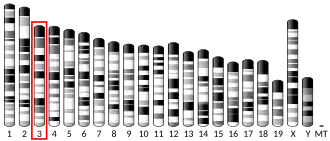G-protein coupled receptor 171 is a protein that in humans is encoded by the GPR171 gene.[5][6] It has been recently deorphanised, with its endogenous agonist being a neuropeptide BigLEN which is a cleavage product of ProSAAS. GPR174 has been found to be involved in processes such as pain, anxiety, and appetite regulation, as well as immune system function, and GPR174 agonists may represent a potential target for novel analgesic drugs. Interestingly it seems to show sex-selective signalling, with effects seen in male mice often absent in female mice.[7][8][9][10][11][12][13][14][15][16]
Ligands
- Agonists
References
- ^ a b c GRCh38: Ensembl release 89: ENSG00000174946 – Ensembl, May 2017
- ^ a b c GRCm38: Ensembl release 89: ENSMUSG00000050075 – Ensembl, May 2017
- ^ "Human PubMed Reference:". National Center for Biotechnology Information, U.S. National Library of Medicine.
- ^ "Mouse PubMed Reference:". National Center for Biotechnology Information, U.S. National Library of Medicine.
- ^ Jacobs KA, Collins-Racie LA, Colbert M, Duckett M, Golden-Fleet M, Kelleher K, et al. (Dec 1997). "A genetic selection for isolating cDNAs encoding secreted proteins". Gene. 198 (1–2): 289–296. doi:10.1016/S0378-1119(97)00330-2. PMID 9370294.
- ^ "Entrez Gene: GPR171 G protein-coupled receptor 171".
- ^ Fricker LD, Devi LA (2018). "Orphan neuropeptides and receptors: Novel therapeutic targets". Pharmacology & Therapeutics. 185: 26–33. doi:10.1016/j.pharmthera.2017.11.006. PMC 5899030. PMID 29174650.
- ^ McDermott MV, Afrose L, Gomes I, Devi LA, Bobeck EN (2019). "Opioid-Induced Signaling and Antinociception Are Modulated by the Recently Deorphanized Receptor, GPR171". The Journal of Pharmacology and Experimental Therapeutics. 371 (1): 56–62. doi:10.1124/jpet.119.259242. PMC 6750184. PMID 31308196.
- ^ Ram A, Edwards T, McCarty A, Afrose L, McDermott MV, Bobeck EN (2021). "GPR171 Agonist Reduces Chronic Neuropathic and Inflammatory Pain in Male, but Not Female Mice". Frontiers in Pain Research. 2 695396. Lausanne, Switzerland. doi:10.3389/fpain.2021.695396. PMC 8915562. PMID 35295419.
- ^ Fujiwara Y, Torphy RJ, Sun Y, Miller EN, Ho F, Borcherding N, et al. (2021). "The GPR171 pathway suppresses T cell activation and limits antitumor immunity". Nature Communications. 12 (1) 5857. Bibcode:2021NatCo..12.5857F. doi:10.1038/s41467-021-26135-9. PMC 8494883. PMID 34615877.
- ^ Aryal DK, Rodriguiz RM, Nguyen NL, Pease MW, Morgan DJ, Pintar J, et al. (2022). "Mice lacking proSAAS display alterations in emotion, consummatory behavior and circadian entrainment". Genes, Brain, and Behavior. 21 (7) e12827. doi:10.1111/gbb.12827. PMC 9444949. PMID 35878875.
- ^ Afrose L, McDermott MV, Bhuiyan AI, Pathak SK, Bobeck EN (2022). "GPR171 activation regulates morphine tolerance but not withdrawal in a test-dependent manner in mice". Behavioural Pharmacology. 33 (7): 442–451. doi:10.1097/FBP.0000000000000692. PMC 9477863. PMID 35942845.
- ^ McDermott MV, Ram A, Mattoon MT, Haderlie EE, Raddatz MC, Thomason MK, et al. (2023). "A small molecule ligand for the novel pain target, GPR171, produces minimal reward in mice". Pharmacology, Biochemistry, and Behavior. 224 173543. doi:10.1016/j.pbb.2023.173543. PMC 11472835. PMID 36933620.
- ^ Fricker LD, Fakira AK, Bobeck EN, Raddatz M, Kim K, Deschepper KD, et al. (2025). "ProSAAS neuropeptides and receptors GPR171 and GPR83: Potential therapeutic applications for pain, anxiety, and body weight regulation". The Journal of Pharmacology and Experimental Therapeutics. 392 (6) 103599. doi:10.1016/j.jpet.2025.103599. PMID 40450835.
- ^ Kou F, Li XY, Feng Z, Hua J, Wu X, Gao H, et al. (2025). "GPR171 restrains intestinal inflammation by suppressing FABP5-mediated Th17 cell differentiation and lipid metabolism". Gut. 74 (8): 1279–1292. doi:10.1136/gutjnl-2024-334010. PMID 40074327.
- ^ Raddatz MC, Newson CM, Stott M, Campbell C, Bobeck EN (2025). "GPR171 is necessary for normal physiological functions and mood-related behaviors in males, but not females". Behavioural Brain Research. 490 115618. doi:10.1016/j.bbr.2025.115618. PMID 40318809.
Further reading
- Adams MD, Kerlavage AR, Fleischmann RD, Fuldner RA, Bult CJ, Lee NH, et al. (Sep 1995). "Initial assessment of human gene diversity and expression patterns based upon 83 million nucleotides of cDNA sequence" (PDF). Nature. 377 (6547 Suppl): 3–174. PMID 7566098.
- Joensuu T, Hämäläinen R, Yuan B, Johnson C, Tegelberg S, Gasparini P, et al. (Oct 2001). "Mutations in a novel gene with transmembrane domains underlie Usher syndrome type 3". American Journal of Human Genetics. 69 (4): 673–684. doi:10.1086/323610. PMC 1226054. PMID 11524702.
- Strausberg RL, Feingold EA, Grouse LH, Derge JG, Klausner RD, Collins FS, et al. (Dec 2002). "Generation and initial analysis of more than 15,000 full-length human and mouse cDNA sequences". Proceedings of the National Academy of Sciences of the United States of America. 99 (26): 16899–16903. Bibcode:2002PNAS...9916899M. doi:10.1073/pnas.242603899. PMC 139241. PMID 12477932.




